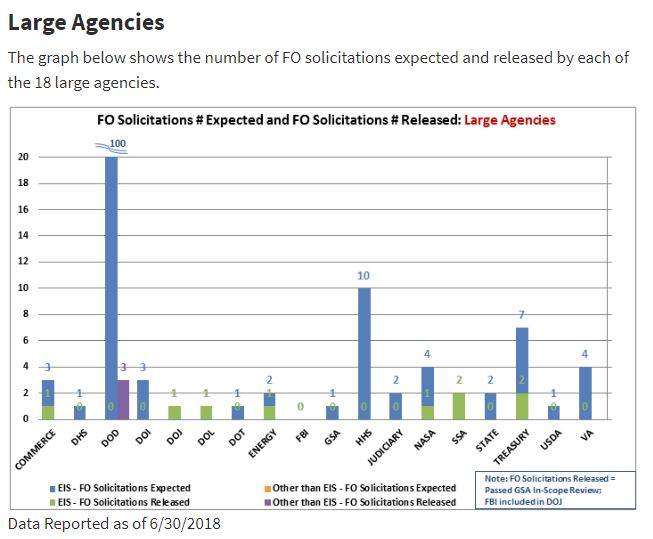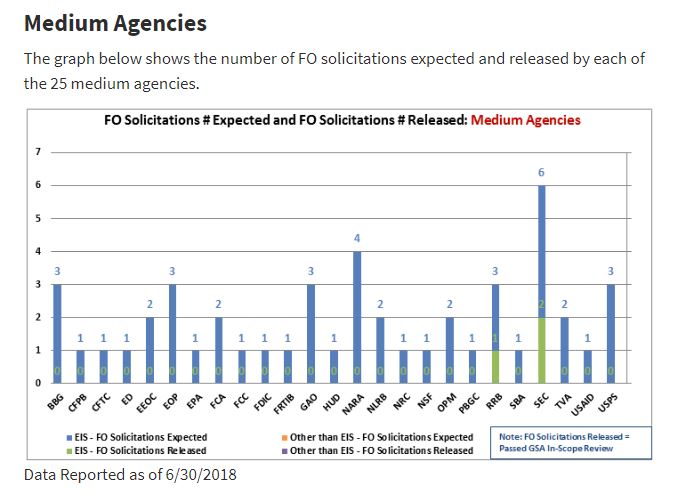

Three agencies, Labor, Justice and SSA, have released solicitations under GSA’s telecommunications contract.
Best listening experience is on Chrome, Firefox or Safari. Subscribe to Federal Drive’s daily audio interviews on Apple Podcasts or PodcastOne.
The idea of iterative or agile development hasn’t quite come to the Enterprise Infrastructure Solutions (EIS) contract.
If the initial handful of fair opportunity soliticiations are any indication of what’s to come, the pressure on agencies to transition to the new $50 billion telecommunications contract run by the General Services Administration by May 2020 is pushing them to take a “winner take all” approach.
And industry experts say that approach likely means the Trump administration’s goal of using EIS to jumpstart IT modernization efforts will be overlooked.
Diana Gowen, general manager and senior vice president for MetTel’s federal program, said based on what she’s seen from the three solicitations so far, agencies are mostly taking a “like-for-like approach and asking vendors to tell them how they would modernize in order to get going. It’s not unlike Networx. So despite OMB pushing and all that stuff, it looks like same old same old, which is unfortunate.”
Denny Groh, executive director for corporate relations for Accelera Solutions, an IT services firm, and a former GSA executive who managed the FTS 2000 and FTS 2001 long distance contracts before retiring in 2003, said while agencies may be motivated to transform through EIS, he estimates less than one-third will actually do anything different.
“A lot of agencies don’t necessarily have all the buy-in of their sub entities and that makes it tough to get a unified front to figure out what they have and what they will do,” he said. “Many will do like-for-like, or they are going to transform in some moderate way.”

Both Groh and Gowen pointed to the three fair opportunity solicitations that are out today as an initial small sample size of the direction EIS may be heading.
The departments of Labor and Justice are among the first out of the gate and both solicitations are taking the “winner take all” approach for voice, video and data.
Justice is taking an interesting approach, Gowen said. The agency issued one solicitation, but it has three sections: one for the FBI’s voice and data where the vendor needs a top secret facility clearance, one for just the Bureau of Prisons telecommunications needs and finally one for the rest of DoJ. Vendors can bid on all three or any combination of the three.
The Social Security Administration, which was the first agency to release its request for proposal, wasn’t much better, looking for a vendor to provide data and voice services, which accounts for a majority of the agency’s needs.
The fact that these agencies seemingly are not transforming or modernizing through EIS doesn’t bode well for GSA’s situation that is getting tougher by the month. The Networx contract ends in May 2020 and GSA has said many times it doesn’t want to extend the contract so agencies have to get their transitions done.
Kay Ely, GSA’s assistant commissioner for the Office of Information Technology Category (ITC) in the Federal Acquisition Service, opened the door slightly to an extension saying in July that if agencies can show they are transforming more than transitioning to EIS, then an extension may be possible.
“If an agency says all I can do between now and May 2020 is like-for-like, then extensions are off the table,” Ely said at an AFFIRM event on July 26. “But if they are doing a hybrid or partial transformation and there is only so much work that can be done, we know in the back of our minds an extension is still out there. But agencies need to put all their efforts into transformation.”
But Groh Gowen and others say an extension is all but assured.
As of Aug. 8, GSA reported four of nine EIS vendors have completed the business support systems testing, and all nine contractors will not be done until early November at the soonest.
After the BSS functional testing, all vendors’ systems must go through the final security approval process.
“GSA is now beginning to be concerned about how get everyone through that authority to operate (ATO) hurdle. They are thinking about how do they expedite this ATO process,” Gowen said. “One of the things that has been suggested is for those awardees who want to work on sprint can nominate themselves to get to the FISMA moderate accreditation faster. We certainly would raise our hands.”
Gowen said given the timeline of vendors not getting ATOs until the spring, GSA likely will have little choice but to extend Networx.
“As we are working with agencies we suggest, as they craft proposals, that they factor in whether all of their modernization goals are achievable within the targeted transition timelines. Timeframes are going to be aggressive,” said a Verizon spokeswoman by email. “When agencies are making their decisions, they should consider past performance to determine if the vendor they are selecting is capable of executing on an aggressive transition. Agencies must balance the urgency of transition with the necessity of modernization.”

The Interior Department may be one of the IT modernization outliers under EIS.
Tim Quinn, Interior’s chief of enterprises infrastructure, said at the Network Modernization Forum in June sponsored by ACT-IAC, that the agency started discussing what transformation would look liked under EIS more than a year ago.
“Go big means citizen delivery,” Quinn said. “If we have better, more complete big data driven, high performance computing heavy model driven interoperability between what USGS does with ground water and surface water with what NOAA does with its weather models, we can get much better predictions of things like [the flooding] in Ellicott City, Maryland. So when I talk about going big with EIS ,in order to do those things I have to be prepared to deliver 100,000 sensors over the next few years. So going big is putting your business first.”
Quinn said Interior is looking for technology that industry may not be ready for today but since EIS is a 15-year contract there are a lot of possibilities on the horizon.
“We have tremendous change capacity built into the contract. I can write and award a new fair opportunity a year later,” he said. “We continue to write fair opportunities under Networx. We made changes along the way. One we did was a broadband fair opportunity through Networx and brought in a technology we didn’t even think about when we started Networx. I think it’s been a good thing for both Interior and government.”
Quinn said that approach is the future of EIS as well where agencies can bring on new technologies as they are ready.
“We want to get off Networx as fast as humanely possible, but we also want to change as fast as possible,” he said. “I have customers who view me as a dinosaur. We are behind and we need to be innovative so we need to partner with everybody to help each other get there faster.”
Gary Hall, the director of strategy, planning and operations at Cisco, said transformation for many agencies doesn’t have to mean a full scale revolution, but more of an evolution.
“They should transform themselves from a perspective of providing operations and maintenance of on-premise gear to brokering the services they need, however they need whether on-premise or in the cloud,” Hall said.
Copyright © 2025 Federal News Network. All rights reserved. This website is not intended for users located within the European Economic Area.
Jason Miller is executive editor of Federal News Network and directs news coverage on the people, policy and programs of the federal government.
Follow @jmillerWFED

